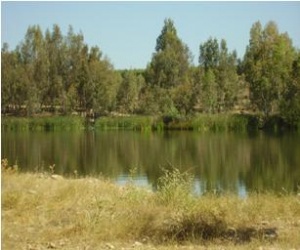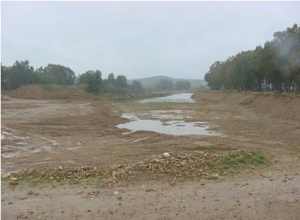Difference between revisions of "Zújar."
(→Measures selection) |
m (→Site description) |
||
| (7 intermediate revisions by the same user not shown) | |||
| Line 22: | Line 22: | ||
==Site description== | ==Site description== | ||
| − | + | ||
| + | [[Image:Zujar2.JPG|left|thumb|300px|the Zújar river before the restoration]] [[Image:Zujar3.JPG|center|thumb|300px|Abandoned gravel extraction sites. ]]<br /><br /><br /> | ||
| + | |||
==Measures selection== | ==Measures selection== | ||
'''Attention:''' The source of the text is the National strategy for River Restoration Bulletin, Sauce nº 1 (November 2009).<br /><br /> | '''Attention:''' The source of the text is the National strategy for River Restoration Bulletin, Sauce nº 1 (November 2009).<br /><br /> | ||
| Line 28: | Line 30: | ||
:*Treatments for improve the health status of the existing vegetation, through prunings, removal of of dead trees;clearing brush in areas where riparian habitats are going to be restored and the dominance of brambles means competition for the regeneration of tree specimens. Exotic species, like the eucalyptus, which appears over the whole reach in small stands or isolated, will be removed progressively as it means competition with the rest of riparian species. Clearing will be done in poplars for reducing the density and facilitate the subsequent introduction of native species which increase the diversity.<br /> | :*Treatments for improve the health status of the existing vegetation, through prunings, removal of of dead trees;clearing brush in areas where riparian habitats are going to be restored and the dominance of brambles means competition for the regeneration of tree specimens. Exotic species, like the eucalyptus, which appears over the whole reach in small stands or isolated, will be removed progressively as it means competition with the rest of riparian species. Clearing will be done in poplars for reducing the density and facilitate the subsequent introduction of native species which increase the diversity.<br /> | ||
:*Other measure planned is the recovery of gravel extraction areas that didn´t have the correct restoration at the time they were abandoned, through the stabilization and the regularization of the terrain. Bioengineering techniques were chosen for stabilize the shore,since their high effectiveness has been demonstrated for this aim. Live stakes,live fascines and brush mattresses will reduce the erosion and give refuge to the aquatic wildlife.<br /> | :*Other measure planned is the recovery of gravel extraction areas that didn´t have the correct restoration at the time they were abandoned, through the stabilization and the regularization of the terrain. Bioengineering techniques were chosen for stabilize the shore,since their high effectiveness has been demonstrated for this aim. Live stakes,live fascines and brush mattresses will reduce the erosion and give refuge to the aquatic wildlife.<br /> | ||
| − | :*Since the reach has a great ecological potential, certain measures are aimed to promote the establishment of communities related to aquatic environment until the environment is recovered and becomes the suitable habitat for these species. To enhance the presence of otters, revegetation and construction of burrows for breeding will be done at degraded riparian zones. The availability of nesting sites for birds and bats will be increased by placing artificial nests given the scarcity of large trees. | + | :*Since the reach has a great ecological potential, certain measures are aimed to promote the establishment of communities related to aquatic environment until the environment is recovered and becomes the suitable habitat for these species. To enhance the presence of otters, revegetation and construction of burrows for breeding will be done at degraded riparian zones. The availability of nesting sites for birds and bats will be increased by placing artificial nests given the scarcity of large trees. To increase the diversity of aquatic habitats and the availability of refuge, boulders and wing deflectors are placed in the channel. To mitigate the barrier effect of the Zújar canal, 16 passes that can be used by mammals, reptiles and amphibians.<br /> |
| + | :*To complement these measures, the results of the project will be disseminated, and an awareness campaign will be carried out. | ||
==Success criteria== | ==Success criteria== | ||
| Line 37: | Line 40: | ||
==Monitoring before and after implementation of the project== | ==Monitoring before and after implementation of the project== | ||
| + | The project is monitored to determine the effectiveness of the measures, and their use in future projects. | ||
==Socio-economic aspects== | ==Socio-economic aspects== | ||
| + | The total budget for carry out the rehabilitation and restoration of 30 Km of the Zújar river is 16.240.282 €. The extent of the project is limited to the Public Hydraulic Domain as the first stage of what could be a more ambitious project like recovering the floodplain by land acquisition to give more space to the river, etc. | ||
==Contact person within the organization== | ==Contact person within the organization== | ||
| + | :Nicolás Cifuentes y de la Cerra<br /> | ||
| + | :Jefe de Servicio de Aplicaciones Forestales de la Confederación Hidrográfica del Guadiana<br /> | ||
| + | :ncifuentes@chguadiana.es | ||
==Extra background information== | ==Extra background information== | ||
Latest revision as of 18:32, 17 May 2010
Zújar.
Key features of the case study
- This project is part of the National Strategy for River Restoration (an initiative of the Ministry of Environment and developed at the Zújar river by the Confederación Hidrográfica del Guadiana) and the State Special Fund for Revitalize Economy and Jobs (Plan E) . The full project covers 30 km of the river, and for facilitating the execution of the works is divided in four sub-projects.[1] [2] [3] [4]
- The project is based on an extense and deep study of the river reach carried out by the Centro de Estudios y Experimentación de Obras Públicas del Ministerio de Fomento (CEDEX)[5] and the Study for the management, restoration and comprehensive use of the resources of the Zújar river and Action Plan done by the Centro de Estudios Socio-económicos de Extremadura (CESEX) for the Comunidad Autónoma de Extremadura.
- The Zújar river is regulated upstream by two dams (La Serena dam and Zújar dam) circumstance that makes imposible to return to the situation prior to this anthropogenic disturbance. The objective of the project is then the rehabilitation or renaturalization of this river reach, as certain pressures cannot be removed.
- The main objectives of the project are:
- Restoration and conservation of the riparian vegetation.
- To consolidate the longitudinal connectivity and the lateral connectivity of the fluvial ecosystem.
- Preserve the Public Hydraulic Domain from new pressures.
- Environmental education and awareness through the development of outreach activities.
- To enable the wildlife mobility.
- Monitoring the biological and physical factors of the reach.
Site description
Measures selection
Attention: The source of the text is the National strategy for River Restoration Bulletin, Sauce nº 1 (November 2009).
As the main objective of the project is the improvement and restoration of the riparian vegetation, there are planned several actions aimed to recover disappeared vegetable communities at certain areas and to enrich and diversify degraded communities.
- Treatments for improve the health status of the existing vegetation, through prunings, removal of of dead trees;clearing brush in areas where riparian habitats are going to be restored and the dominance of brambles means competition for the regeneration of tree specimens. Exotic species, like the eucalyptus, which appears over the whole reach in small stands or isolated, will be removed progressively as it means competition with the rest of riparian species. Clearing will be done in poplars for reducing the density and facilitate the subsequent introduction of native species which increase the diversity.
- Other measure planned is the recovery of gravel extraction areas that didn´t have the correct restoration at the time they were abandoned, through the stabilization and the regularization of the terrain. Bioengineering techniques were chosen for stabilize the shore,since their high effectiveness has been demonstrated for this aim. Live stakes,live fascines and brush mattresses will reduce the erosion and give refuge to the aquatic wildlife.
- Since the reach has a great ecological potential, certain measures are aimed to promote the establishment of communities related to aquatic environment until the environment is recovered and becomes the suitable habitat for these species. To enhance the presence of otters, revegetation and construction of burrows for breeding will be done at degraded riparian zones. The availability of nesting sites for birds and bats will be increased by placing artificial nests given the scarcity of large trees. To increase the diversity of aquatic habitats and the availability of refuge, boulders and wing deflectors are placed in the channel. To mitigate the barrier effect of the Zújar canal, 16 passes that can be used by mammals, reptiles and amphibians.
- To complement these measures, the results of the project will be disseminated, and an awareness campaign will be carried out.
- Treatments for improve the health status of the existing vegetation, through prunings, removal of of dead trees;clearing brush in areas where riparian habitats are going to be restored and the dominance of brambles means competition for the regeneration of tree specimens. Exotic species, like the eucalyptus, which appears over the whole reach in small stands or isolated, will be removed progressively as it means competition with the rest of riparian species. Clearing will be done in poplars for reducing the density and facilitate the subsequent introduction of native species which increase the diversity.
Success criteria
Ecological response
Hydromorphological response
Monitoring before and after implementation of the project
The project is monitored to determine the effectiveness of the measures, and their use in future projects.
Socio-economic aspects
The total budget for carry out the rehabilitation and restoration of 30 Km of the Zújar river is 16.240.282 €. The extent of the project is limited to the Public Hydraulic Domain as the first stage of what could be a more ambitious project like recovering the floodplain by land acquisition to give more space to the river, etc.
Contact person within the organization
- Nicolás Cifuentes y de la Cerra
- Jefe de Servicio de Aplicaciones Forestales de la Confederación Hidrográfica del Guadiana
- ncifuentes@chguadiana.es
Extra background information
References
- ↑ Factsheet of the Zújar restoration nº 1 [[1]]
- ↑ Factsheet of the Zújar restoration nº 2 [[2]]
- ↑ Factsheet of the zújar restoration nº 3 [[3]]
- ↑ Factsheet of the Zújar restoration nº 4 [[4]]
- ↑ Department of Environmental Engineering (CEDEX). Projects of fluvial systems restoration [[5]]
- ↑ Web site of the Zújar restoration project[[6]]
- ↑ [7]
Related Measures
- Develop riparian forest
- Revegetate riparian zones
- Construct semi-natural/articificial wetlands or aquatic habitats

